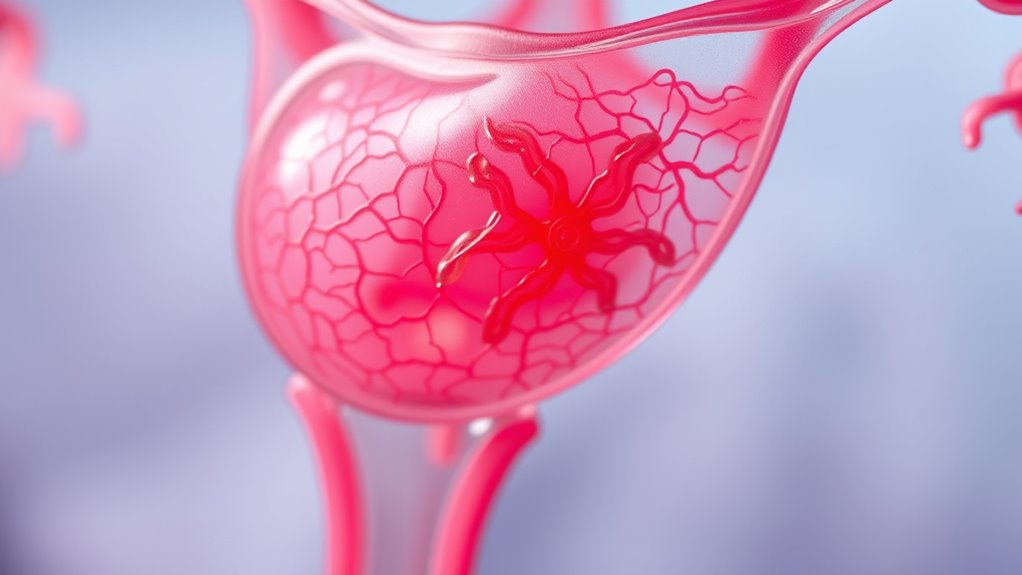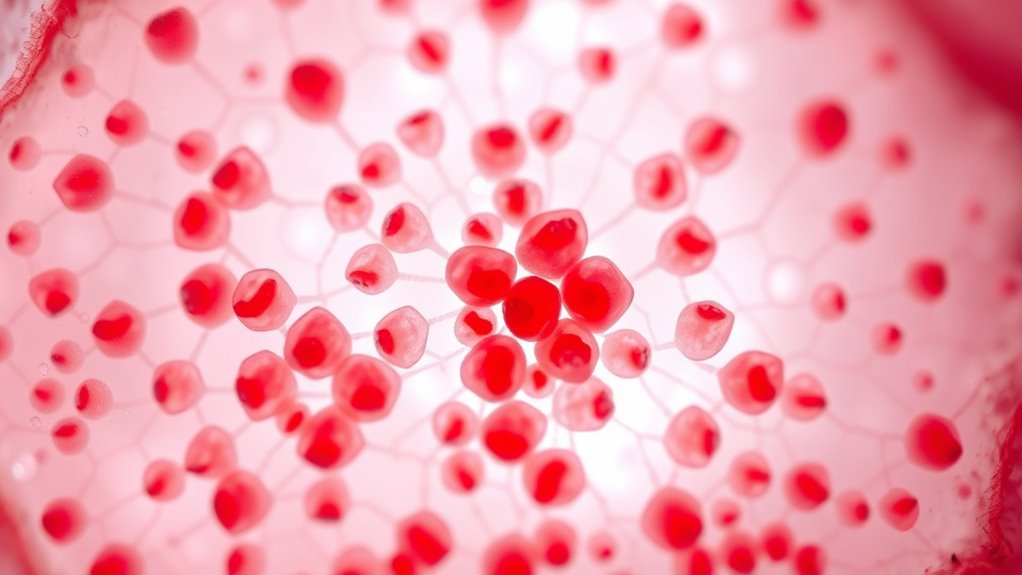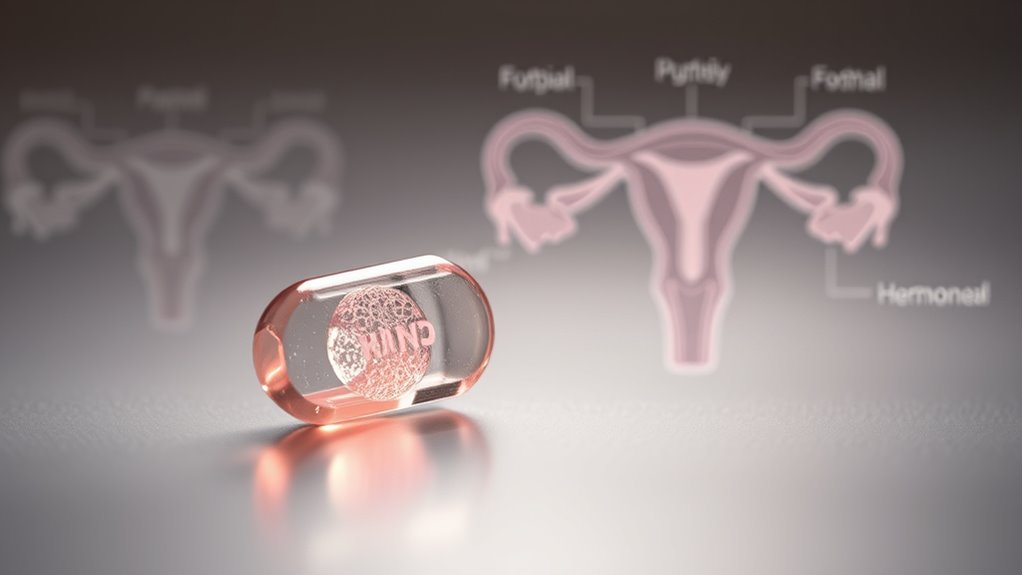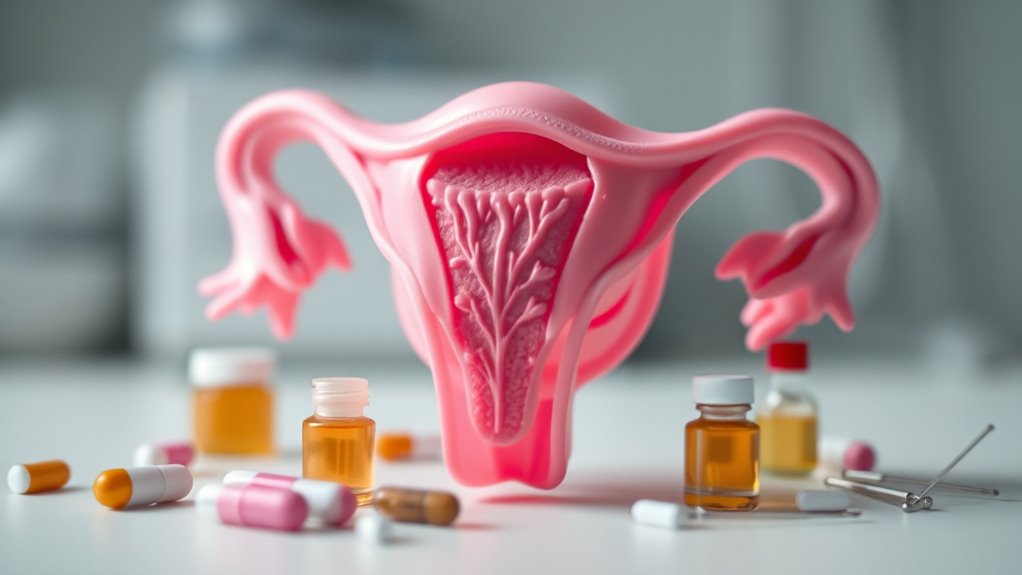Endometriosis develops through theories like retrograde menstruation and coelomic metaplasia, involving tissue growth outside the uterus that causes pain and inflammation. Non-surgical treatments focus on hormonal therapy, pain management, and holistic approaches such as stress reduction, diet, and lifestyle changes. Advances aim to provide relief without invasive procedures, offering hope for better quality of life. Exploring these options can help you manage symptoms more effectively—if you want to know more, keep exploring the latest developments.
Key Takeaways
- Theories include retrograde menstruation and coelomic metaplasia, explaining tissue growth outside the uterus and in various locations.
- Immune response dysregulation contributes to the development and persistence of endometrial lesions.
- Non-surgical treatments focus on hormonal therapy, pain management, lifestyle modifications, and holistic approaches like mindfulness.
- Emerging medications aim to target immune and inflammatory pathways with fewer side effects.
- Mind-body techniques, dietary changes, and stress reduction are effective non-invasive strategies to improve quality of life.
Understanding Endometriosis: An Overview of the Disease

What exactly is endometriosis, and how does it affect your body? It’s a condition where tissue similar to the uterine lining grows outside your uterus, causing pain and discomfort. Your genetic factors play a role here—if endometriosis runs in your family, you’re more likely to develop it. Your immune response also influences the disease; sometimes, your immune system struggles to recognize and clear misplaced tissue, allowing it to persist and worsen symptoms. This abnormal tissue can lead to inflammation, scar formation, and damage to nearby organs. Additionally, the immune response is a key factor in how your body reacts to and manages the disease, affecting symptom severity. Understanding these underlying factors helps explain why endometriosis is complex and varies from person to person. Recognizing the role of genetics and immune response is essential in comprehending how this disease develops and persists in your body. Additionally, the high prevalence of immune dysregulation in affected individuals may contribute to the persistence and severity of symptoms.
Theories Explaining the Development of Endometriosis

You might wonder how endometriosis develops, and experts have proposed several theories. The retrograde menstruation hypothesis suggests menstrual blood flows backward into the pelvis, carrying endometrial cells with it. Alternatively, the coelomic metaplasia theory proposes that cells lining the abdominal cavity transform into endometrial tissue.
Retrograde Menstruation Hypothesis
The Retrograde Menstruation Hypothesis suggests that during menstruation, some endometrial tissue flows backward through the fallopian tubes into the pelvic cavity instead of exiting the body. This process, known as menstrual reflux, allows endometrial cells to reach areas outside the uterus. Once in the pelvic cavity, this tissue can adhere to surfaces and tissues, leading to tissue implantation and the development of endometrial lesions. Not everyone experiences this, which is why other factors might influence endometriosis development.
| Factor | Impact |
|---|---|
| Menstrual reflux | Facilitates tissue movement into pelvis |
| Tissue implantation | Leads to endometrial tissue growth |
| Immune response | Affects tissue clearance |
| Genetic predisposition | Influences susceptibility |
Coelomic Metaplasia Theory
While the retrograde menstruation hypothesis explains how endometrial tissue might reach the pelvic cavity, it doesn’t account for all cases of endometriosis. The coelomic metaplasia theory suggests that cells lining the pelvic organs can transform into endometrial-like tissue through metaplasia. You should know that stem cell involvement plays a role here, as undifferentiated cells may convert into endometrial tissue abnormally. Additionally, genetic predisposition influences this process; some individuals are more susceptible due to inherited factors that favor cellular transformation. This theory helps explain endometriosis found outside the pelvic cavity and cases with no evidence of menstrual tissue reflux. It highlights the importance of cellular plasticity and genetic factors in the development of this complex condition. Moreover, ongoing research into tissue differentiation and cellular plasticity may provide further insights into how these cellular changes occur, especially concerning stem cell differentiation.
How Endometriosis Spreads and Affects the Body

Endometriosis spreads when endometrial-like tissue grows outside the uterus, often attaching to organs such as the ovaries, fallopian tubes, or the pelvic lining. This process involves lesion dissemination, where small patches of tissue break off from primary sites and implant elsewhere. These lesions infiltrate surrounding tissues, invading muscle layers and connective tissues, which causes persistent inflammation and pain. The tissue infiltration can lead to adhesions, causing organs to stick together and impair their function. As the disease progresses, this spread can be extensive, affecting multiple areas within the pelvic cavity. Understanding lesion dissemination and tissue infiltration helps explain how endometriosis impacts not just localized areas but the overall health of your reproductive and pelvic organs. lesion dissemination is a key process that facilitates the spread of endometrial-like tissue throughout the pelvic cavity. Additionally, this invasive behavior can result in the formation of adhesions, which further complicate treatment and symptom management. Moreover, the ongoing inflammation associated with tissue infiltration can lead to the development of chronic pain, significantly affecting quality of life. Recognizing the role of tissue infiltration in disease progression can assist in developing targeted therapies to manage symptoms effectively.
Emerging Non-Invasive Treatment Options

New developments in endometriosis treatments are focusing on non-invasive options that could reduce discomfort and improve quality of life. You might benefit from novel medications, advancements in hormonal therapy, or innovative pain management techniques. These emerging options aim to provide effective relief without the need for surgery or invasive procedures. For instance, understanding the vetted treatments available can help patients make informed decisions about their care. Additionally, ongoing research into AI-driven diagnostics holds promise for earlier detection and personalized treatment strategies. Incorporating mindfulness practices and stress reduction techniques, aligned with holistic approaches, can further enhance patient well-being. Implementing security measures in medication development and data handling is essential to protect patient information and ensure compliance with evolving regulations.
Novel Medication Developments
Recent advances in medication development are opening up promising non-invasive options for managing endometriosis. Researchers are focusing on targeting the underlying genetic factors that influence disease susceptibility, aiming for more personalized treatments. Additionally, environmental triggers such as toxins and hormonal disruptors are being studied to develop medications that can mitigate their impact on disease progression. These novel drugs aim to modulate immune responses and reduce inflammation without the hormonal side effects associated with traditional therapies. By understanding the complex interplay between genetics and environment, scientists are creating targeted therapies that could offer relief with fewer risks. Exploring homeostasis and how it influences immune regulation is also guiding new treatment strategies. For instance, controlling ingredient stability can be critical in developing medications with longer shelf lives and fewer side effects. Advances in understanding immune modulation are helping researchers design drugs that more precisely address immune dysregulation in endometriosis. Furthermore, incorporating insights from environmental influences can enhance the effectiveness of these emerging therapies. While still in early stages, these developments hold significant potential for transforming endometriosis management beyond surgery and hormonal options.
Hormonal Therapy Advances
Advances in hormonal therapies are paving the way for less invasive options to manage endometriosis symptoms. Recent hormonal therapy advancements focus on improving hormonal regulation while minimizing side effects. New medications target specific hormonal pathways to suppress endometrial tissue growth without the broad suppression seen in traditional treatments. These therapies aim to reduce pain and inflammation more effectively, with a better safety profile. You might find options like selective progesterone receptor modulators or novel GnRH antagonists offering promising results. The goal is to provide tailored hormonal regulation that alleviates symptoms while preserving your quality of life. As research progresses, these hormonal therapy advances offer hope for more precise, less invasive management strategies for endometriosis. Understanding hormonal regulation continues to drive innovation in treatment options. Additionally, ongoing research into hormonal pathways helps develop therapies that are both effective and personalized. Moreover, new findings in endometriosis research are guiding the development of targeted hormonal therapies for improved outcomes. Furthermore, a personalized approach to hormonal treatment is increasingly emphasized to optimize individual patient responses and minimize adverse effects.
Innovative Pain Management
Are there effective non-invasive options to manage endometriosis pain? Yes, emerging treatments focus on the mind-body connection, emphasizing holistic approaches. Techniques like mindfulness meditation and guided imagery can help reduce pain perception by calming your nervous system. You might also explore biofeedback, which teaches you to control physiological responses linked to pain. Psychological support plays a crucial role, helping you address emotional stress that can intensify pain sensations. These methods don’t involve medication or surgery, making them appealing options for long-term management. Incorporating these strategies can empower you to better handle pain, improve your quality of life, and foster resilience. Additionally, understanding how paint sprayers operate and maintaining them properly can serve as a helpful analogy for managing various complex systems in health and well-being. Recognizing the importance of the mind-body connection can deepen your understanding of holistic health practices, offering a more integrated approach to pain management. Techniques such as progressive relaxation can further enhance your ability to relax physically and mentally, reducing overall discomfort. While not a cure, they provide valuable tools to complement existing treatments, emphasizing your overall well-being.
The Role of Hormonal Therapy in Managing Symptoms

Hormonal therapy plays a crucial role in managing the symptoms of endometriosis by regulating or suppressing ovarian hormone production. This approach helps achieve hormonal regulation, which reduces or halts the growth of endometrial tissue outside the uterus. By controlling hormone levels, you can experience better symptom control, especially pain and bleeding. Common options include hormonal contraceptives, GnRH agonists, and progestins, which work by lowering estrogen levels or creating a hormonal environment unfavorable for endometrial tissue growth. These treatments can markedly decrease pain and improve quality of life. However, they may also have side effects, so working closely with your healthcare provider ensures the best balance between symptom relief and potential risks. Hormonal therapy remains a cornerstone in non-surgical endometriosis management.
Lifestyle and Complementary Approaches to Relief

While hormonal therapies can substantially reduce endometriosis symptoms, many women find additional relief through lifestyle and complementary approaches. Mind-body techniques like meditation, deep breathing, and yoga help manage pain and reduce stress, which can exacerbate symptoms. Dietary modifications also play a role; reducing inflammatory foods such as processed sugars, trans fats, and red meat may decrease pain and inflammation. Incorporating anti-inflammatory foods like fruits, vegetables, and omega-3-rich fish supports overall health. Regular exercise, adequate sleep, and stress management are essential components of a holistic approach. These strategies empower you to take control of your symptoms, often resulting in improved well-being and quality of life alongside conventional treatments.
Frequently Asked Questions
What Are the Latest Research Directions for Endometriosis?
You’re curious about the latest research directions for endometriosis. Researchers focus on biomarker discovery to improve diagnosis and personalize treatments, making management more effective. Stem cell research is also advancing, aiming to understand tissue regeneration and potential therapies. These areas hold promise for better understanding the disease and developing non-surgical options, ultimately improving quality of life for those affected. Stay updated as these promising fields evolve rapidly.
Can Diet Modifications Significantly Impact Endometriosis Symptoms?
You might wonder if diet modifications can really impact endometriosis symptoms. Nutritional interventions show promise, as certain dietary changes may reduce inflammation and pain. While the dietary impact varies among individuals, reducing processed foods, adding anti-inflammatory options like omega-3s, and avoiding triggers can help manage symptoms. Though not a cure, these lifestyle adjustments can be a valuable part of your overall treatment plan.
Are There Any New Non-Pharmacological Therapies Under Investigation?
You’re curious about cutting-edge care, so you explore novel physical therapies and alternative medicine. Currently, researchers are investigating innovative non-pharmacological therapies like pelvic floor physical therapy, acupuncture, and mindfulness-based stress reduction. These approaches aim to ease symptoms naturally, offering hope beyond pills and procedures. As science progresses, you may find that holistic, non-invasive options become more prominent, providing personalized relief tailored to your unique experience with endometriosis.
How Does Endometriosis Affect Fertility Long-Term?
You might wonder about the long-term effects of endometriosis on fertility. It can cause scarring and adhesions that impair egg release and transport, reducing your chances of conception over time. Fertility preservation options, like egg or embryo freezing, can help if you’re planning future pregnancies. Hormone therapy can manage symptoms but may temporarily halt ovulation, so it requires careful planning to balance symptom relief and fertility goals.
What Psychological Support Options Are Available for Patients?
You can access various psychological support options to help manage endometriosis. Mental health counseling provides a safe space to process emotions and develop coping strategies. Support groups connect you with others facing similar challenges, reducing feelings of isolation. Online forums and community resources also offer valuable advice and encouragement. Prioritizing your mental health is vital, and these options can empower you to navigate the emotional impacts of endometriosis effectively.
Conclusion
Understanding endometriosis reveals a complex battle between biology and lifestyle. While theories explain its origins and spread, emerging non-invasive treatments offer hope without surgery. Hormonal therapies may ease symptoms, yet lifestyle and complementary approaches empower you to take control. It’s a reminder that managing this condition isn’t just about medication—it’s about balancing science with your everyday choices. In this fight, knowledge and proactive steps become your strongest allies, proving that hope and action go hand in hand.







